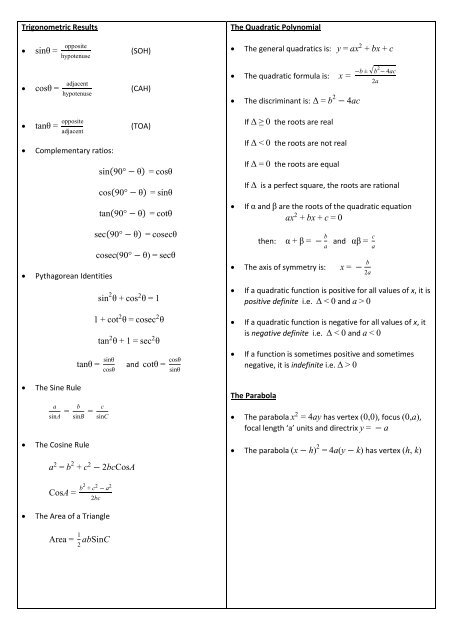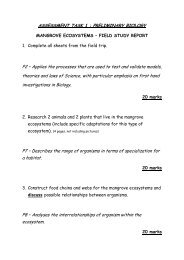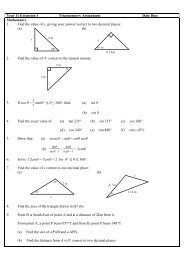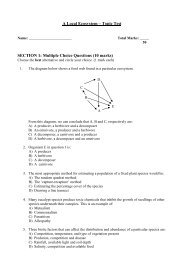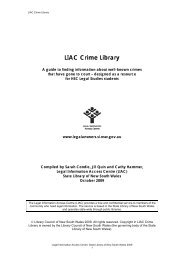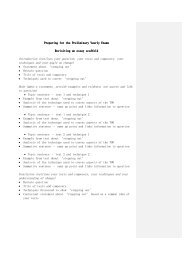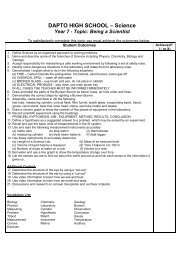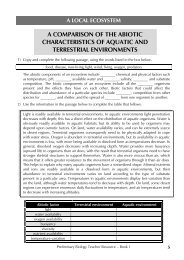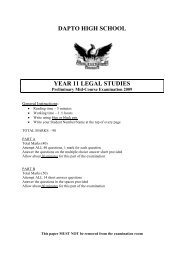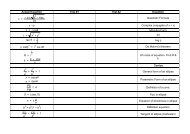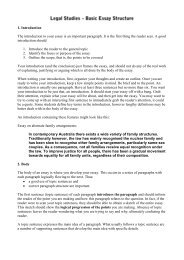MATHEMATICS REVISION OF FORMULAE AND RESULTS
MATHEMATICS REVISION OF FORMULAE AND RESULTS
MATHEMATICS REVISION OF FORMULAE AND RESULTS
Create successful ePaper yourself
Turn your PDF publications into a flip-book with our unique Google optimized e-Paper software.
Trigonometric Results<br />
The Quadratic Polynomial<br />
sinθ =<br />
opposite<br />
hypotenuse<br />
(SOH)<br />
<br />
The general quadratics is: y = ax 2 + bx + c<br />
cosθ =<br />
adjacent<br />
hypotenuse<br />
(CAH)<br />
The quadratic formula is: x = −b ± b2 − 4ac<br />
2a<br />
<br />
The discriminant is: Δ = b 2 − 4ac<br />
<br />
<br />
<br />
tanθ = opposite<br />
adjacent<br />
Complementary ratios:<br />
Pythagorean Identities<br />
(TOA)<br />
sin 90° − θ = cosθ<br />
cos 90° − θ = sinθ<br />
tan 90° − θ = cotθ<br />
sec 90° − θ = cosecθ<br />
cosec(90° − θ) = secθ<br />
sin 2 θ + cos 2 θ = 1<br />
<br />
If Δ ≥ 0 the roots are real<br />
If Δ < 0 the roots are not real<br />
If Δ = 0 the roots are equal<br />
If Δ is a perfect square, the roots are rational<br />
If α and β are the roots of the quadratic equation<br />
ax 2 + bx + c = 0<br />
then: α + β = − b a and αβ = c a<br />
The axis of symmetry is: x = − b<br />
<br />
If a quadratic function is positive for all values of x, it is<br />
positive definite i.e. Δ < 0 and a > 0<br />
2a<br />
1 + cot 2 θ = cosec 2 θ<br />
tanθ = sinθ<br />
cosθ<br />
tan 2 θ + 1 = sec 2 θ<br />
and cotθ = cosθ<br />
sinθ<br />
<br />
<br />
If a quadratic function is negative for all values of x, it<br />
is negative definite i.e. Δ < 0 and a < 0<br />
If a function is sometimes positive and sometimes<br />
negative, it is indefinite i.e. Δ > 0<br />
<br />
<br />
<br />
The Sine Rule<br />
a<br />
= b<br />
= c<br />
sinA sinB sinC<br />
The Cosine Rule<br />
a 2 = b 2 + c 2 − 2bcCosA<br />
CosA = b2 + c 2 − a 2<br />
2bc<br />
The Area of a Triangle<br />
The Parabola<br />
<br />
The parabola x 2 = 4ay has vertex (0,0), focus (0,a),<br />
focal length ‘a’ units and directrix y = − a<br />
The parabola (x − h) 2 = 4a(y − k) has vertex (h, k)<br />
Area = 1 2 abSinC


